



Exploring Italy's capital might conjure up images of Audrey Hepburn and Gregory Peck cruising the Eternal City on a Vespa. But the reality of getting around Rome is very different.
Rome is the biggest city in Italy, covering 496 square miles and incorporating 4.5 million residents. Stretching from the coastline of Ostia in the southwest to the foothills of Tivoli in the northeast, the Italian capital is a big beast to behold, and an even trickier city to cross.
Luckily, Rome's city centre is quite compact (not surprising given it took shape nearly 2,000 years ago). You can walk from the Vatican to the Colosseum in under an hour; Termini train station to the Roman Forum in 30 minutes; and the Trevi Fountain to the Pantheon in the time it takes to devour a gelato.
Most of Rome's main sites are connected by a 24/7 bus, tram and metro service run by Rome's public transport network, ATAC. But ATAC is riddled with issues, and the network is stretched to breaking point. Thankfully, in today's world of Uber, apps, and car shares, getting around Rome has never been so easy. Here's all you need to know for exploring the Eternal City.
Reaching your accommodation after arriving into Rome shouldn't have to break the bank. But unscrupulous taxi drivers and poorly advertised train routes can make the trip appear more complicated than it is.
That's why we've written this dedicated guide to getting from Rome's airports to the city centre.
The best way to explore Rome is on foot. No matter how much you have planned, leave time to lose yourselves among the pock-holed ancient temples, stunning baroque churches, and busy aperitivo bars of the historic centre. Or even better - join us on a walking tour to get your bearings and see Rome's must-see sites.
If walking isn't your thing or you'd rather conserve your energy for the museums, your best options are to take buses, metros, trams or trains. Tickets can be purchased from tabaccherie (tobacconists), edicole (newspaper shops), and ticket machines inside the stations or through the MooneyGo app and cost €1.50 for 100 minutes.
→ Download MooneyGo to purchase all public transport tickets in advance
Please be aware that tickets must be validated before travelling otherwise you risk fines of €50 if paid on the spot or €100+ if deferred. Twenty-four, 48-hour and 72-hour tickets are active from the time of the first validation.
Validating electronic tickets is easy. Just feed them through the barriers at the metro station or insert them into the machines in train stations or against the machines aboard buses and trams. You can also tap your debit or credit card against the ticket machines on most modern buses. Just give it to officials if they come around to check.

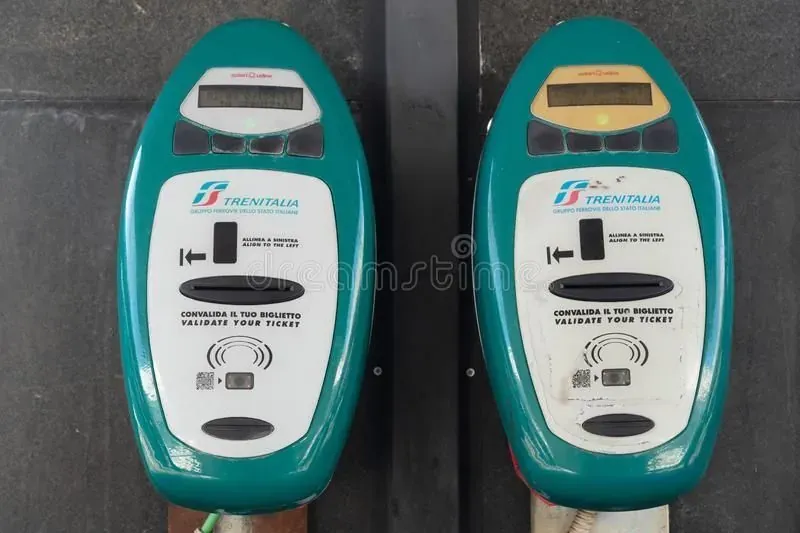
Ticket validation machine for the buses and trams
Ticket validation machine for the trains
Getting around Rome by bus is the best way to travel while getting your bearings. The city is well-serviced 24/7 with Roma Termini and Piazza Venezia acting as the central hubs.
Buses can get pretty packed, especially during rush hour. So if you value personal space at a premium, plan your journey times accordingly. Remember to validate your paper tickets using the machines when you step on the bus or via the app if you've purchased them virtually, and make sure you keep hold of them as officials do come around and check.
Taking the metro is usually the quickest way to cut across the city. Rome's metro system consists of three lines (or two and a half, if we're being honest) - A, B, and to a certain extent C.
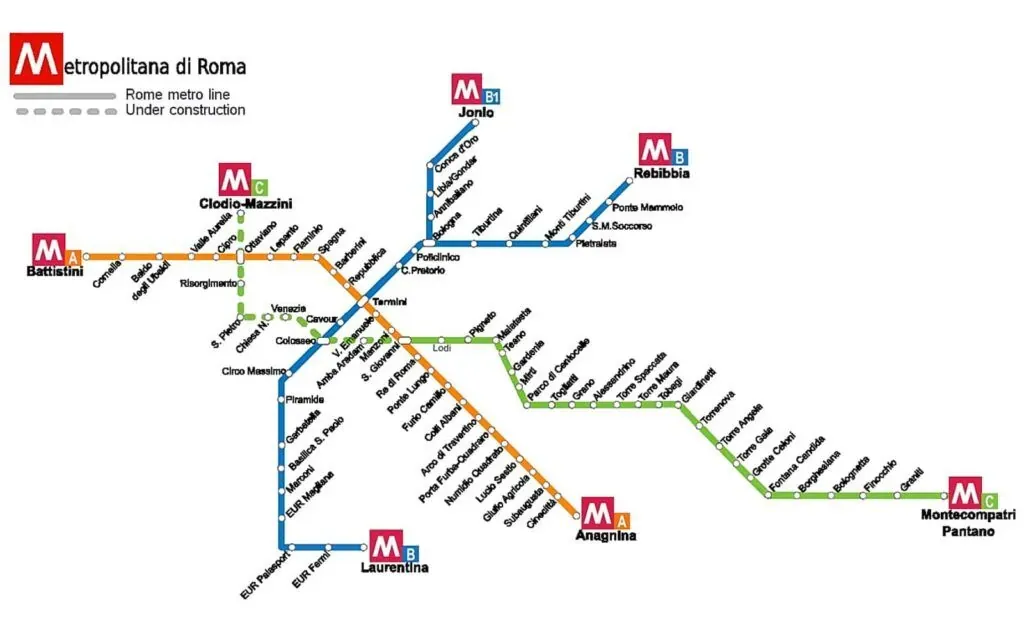
Map of the Roman Metro System (Lines A, B and C)
Line A runs from Cornelia and the Vatican (Cipro / Ottaviano) in the northwest to Cinecittà and Anagnina in the south. Take Line A to reach such sites as the Vatican (Ottaviano station), Borghese Gallery (Flaminio station), Spanish Steps (Spagna station).
Line B runs from Laurentina in the south to Rebbibia in the northeast. Take Line B to reach such sites as the Colosseum (Colosseo station), Testaccio (Piramide station), Circus Maximus (Circo Massimo station), and the Appian Way (Garbatella station). You can change lines at Termini.
Line C has been in construction since what seems like the Age of Augustus. You can join it via Metro San Giovanni on Line A and use it to head east. (Though apart from the trendy, studenty area of Pigneto there's not a whole lot in the way of sightseeing).
Rome's tram network serves two main purposes: connecting Trastevere to Piazza Venezia and joining the neighbourhoods of San Lorenzo (near Termini), the Colosseum, Circus Maximus, Testaccio, and Trastevere. You'll probably only ever use it when getting to/from Trastevere, where there's plenty to see in Trastevere, to the bus terminal of Piazza Venezia in the shadow of the Altar of the Fatherland.
If you're staying near Roma Termini, Roma Trastevere or Roma San Pietro, taking the train might be the best way of getting around Rome.
If you don't want to break the bank by taking Uber and taxis, and risk getting caught up in crawling Roman traffic, your best bet is to check out Rome's vehicle-sharing options.
Rome's centre is well serviced by bikes, e-scooters, and motor scooters you can rent. It works by downloading the app of the respective brand, submitting an ID and a payment form, and then paying per minute or by purchasing a discount package. Download the Free Now app to find your nearest vehicle.
A word of caution: helmets are not provided with bike and e-scooter shares, but if you are planning on renting one it would be worth bringing or buying your own. Roman traffic follows its own laws and you should always treat Rome's roads with caution and respect. Not doing so could transform your Roman holiday into a prolonged and costly visit to the A&E, and nobody wants a stint in hospital as a memory to take back home.
.webp)
.webp)
Eccoltra electric scooter
Dott E-Bike
While we wouldn't recommend getting around Rome in a car, it does give you the most freedom to explore Rome's outskirts or take a trip to the beach.
Driving is by far the quickest and most convenient way to visit places like Tivoli's Villa D'Este in the hills east of Rome and the papal residence of Castel Gandolfo in the Alban Hills to the southeast. It also means you can drive down to Naples (in just under 3 hours) and Pompeii or Florence (in just under 4 hours) and Chianti.
→ Visit Discover Cars to compare the best car rental prices and deals.
The quickest and most scenic way to get around Rome is by scooter. But if you value life and limb, you might want to take advantage of Rome's public transport network of buses and trams for shorter distances, and metros and trains for longer distances.
A standard public transport ticket costs €1.50 and is valid for 100 minutes from activation. Travellers visiting Rome for longer might want to consider purchasing passes for 24 hours (€7), 48 hours (€12), or 72 hours (€18.50).
Rome's public transport is perfectly safe. Of course, there are instances of petty crimes like pickpocketing, as in any other major city, and you should exercise common sense in flashing valuable jewellery and technological gadgets late at night or among crowds. But Romans tend to be neither quiet nor complicit when they see criminal acts and are likely to step in.
We'd suggest either walking or taking the bus, depending on the distance. Buses can get pretty packed, especially around the centre. But Italians are nothing if not family-friendly and will always make way for you and your baby. Bear in mind that the city's cobbled centre isn't especially stroller-friendly. Combined with the crowds, you might want to opt for a baby carrier instead.

No headings found in content.
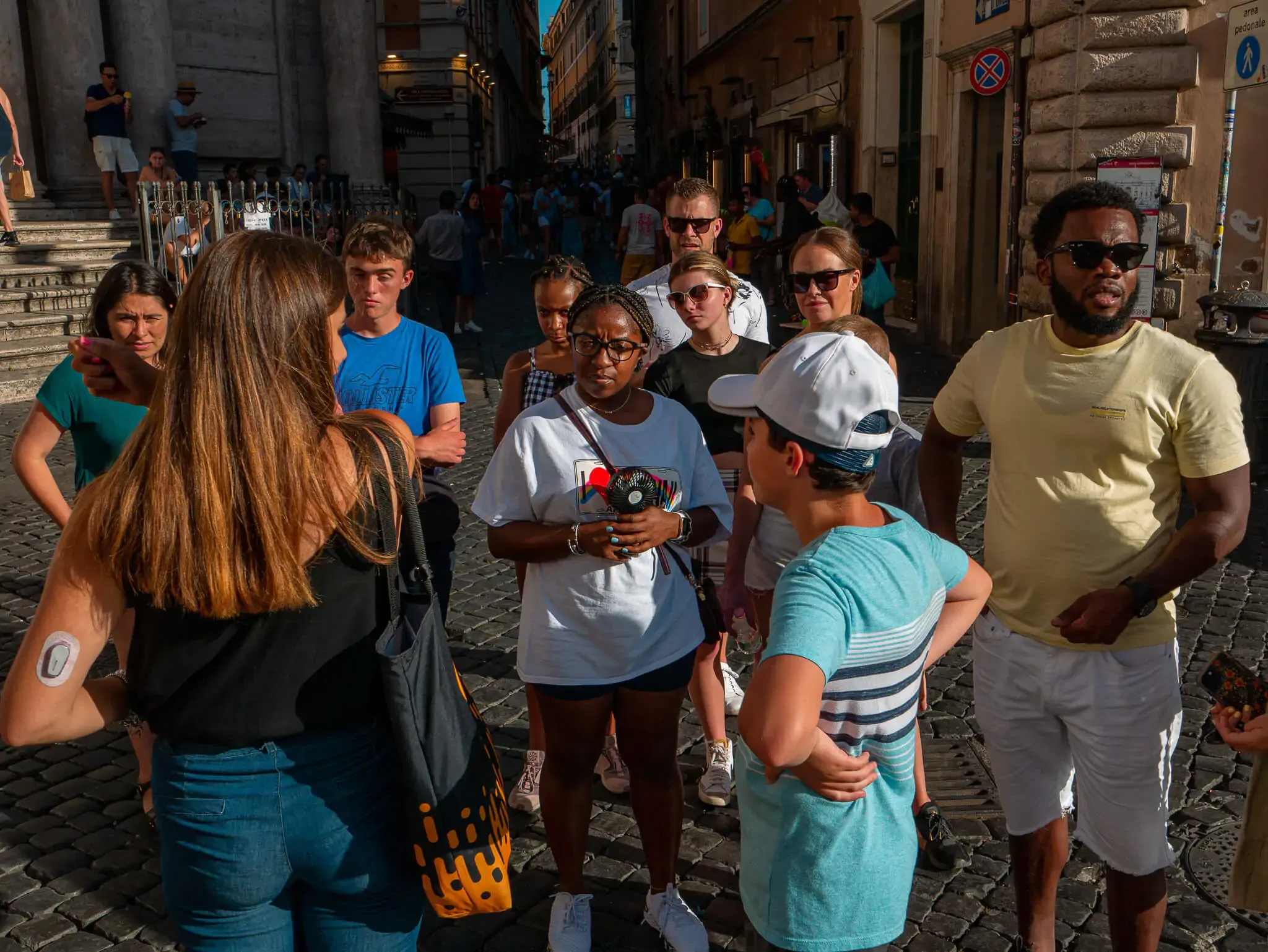
Explore the wonders of the Eternal City on our best of Rome walking tour. As you get your bearings around Rome’s cobbled historic centre, your expert storyteller will bring Rome’s most must-see sites to life, including the Pantheon, Trevi Fountain, and Piazza Navona. Take photos, make memories, and most importantly, get the most out of your time in the Italian capital!
Your private guide will share the city’s secrets and narrate its story in a way that will make you feel like you’ve stepped back in time – from explaining how the stunningly intricate churches and palaces were erected, to how the grand fountains were used to channel water throughout the city.
We will start at Trajan’s Column, which portrays the bloody victory of the emperor during the Dacian wars in Eastern Europe. We’ll then head to the Piazza Venezia, the crossroads between the ancient city and the modern capital and one of the most scenic squares in Italy!
After taking a moment to marvel at the imposing Altar of the Fatherland, we’ll make our way to the iconic Trevi Fountain. Toss a coin into the fountain, spend a moment soaking in its sounds and scenery (metaphorically, not literally!), and uncover the fascinating stories behind the fountain’s statues and symbols.
After discovering the incredible frescoes within the church of Sant Ignazio, we’ll make our way to the Pantheon where the spectacle of the 2000-year-old dome will blow you away. Marvel at one of the best-preserved buildings of the ancient world, hear the story behind the man who built it, and discover the shocking architectural secret behind how the dome is (or isn’t) supported!
Your private walking tour of Rome finishes at Piazza Navona. The square is situated near some of Rome’s best and most vibrant bars and restaurants and your guide will be happy to recommend where to go.
This tour is suitable for people of all ages and fitness levels. You can expect this memorable experience to last about two hours, which leaves you with more than enough time to explore the city beyond.

Most of history's great artists enjoyed a drink or two; just look at Van Gogh's Starry Night and tell us that's how the sky looks. Now you can unleash your inner Leonardo with sips of unlimited wine and a nibble of Roman-style pizza in our Tipsy Art Class. Join a small group of fellow budding artists to recreate iconic Roman monuments and landscapes that will rival the works of Michelangelo. If he were blind, drunk, and not even trying.
A professional local arts instructor will guide you through the techniques that made the Great Masters great while you fill yourself with the spirit that inspired them. First, your art instructor will give you a crash course in brushstrokes and blending before you choose your muse and recreate it in your own style, or get creative and paint from your imagination.
During the course of 2 and a half fun-filled hours, you and your fellow artists will sip and paint in the comfort of a 17th-century palazzo. Indulge in unlimited red and white Italian wine, snack on pizza, and make a masterpiece. The best part? You get to take your canvas home with you--unless you overdo it on the vino, in which case we have plenty of space in the bins!
Ready to get merry with Michelangelo? Create a one-of-a-kind souvenir and bring a piece of Rome back home.

We’re spinning up festive flavours, Italian-style! From December 1st until January 6th, our pasta and tiramisu class gets a holiday twist, complete with mulled wine magic and made-from-scratch fun.
Learn to cook like an Italian in this small group pasta & tiramisù cooking class that gives you mastery over the country’s best-loved classics. Over the course of three fun-filled hours, you’ll enjoy the expert guidance of our fluent professional chef and get hands on recreating real Roman recipes, culminating in a well-deserved dinner and dessert.
Situated in our centrally situated air-conditioned cooking school, your interactive class will give you the true sense of an Italian nonna’s loving kitchen. Led by an enthusiastic and knowledgeable English-speaking chef, our cooking masterclass is perfect for kids and adults, beginners and experts.
Savoiardi (ladyfingers) are gently dipped in rich coffee before being layered with dollops of delicately mixed eggs and panna (cream). Finished off with a sprinkle of cocoa, these delicious desserts are set aside to rest in time for an after-dinner energy boost. In fact, the espresso within a tiramisù is what gives it a name that translates literally as “pick me up”!
Rolling up our sleeves, here is where we channel our inner nonna. Mixing, kneading, rolling, and shaping our fresh pasta from scratch will work up a sweat but result in elegant end products. We will then combine these carefully crafted creations with the flavours of the season and locality; be it twangy cacio e pepe or creamy carbonara.
How else to conclude your cooking class than by fully indulging in your culinary creations! Celebrate your accomplishment with family-friendly company, a gorgeous setting, and a glass of local wine or prosecco.
Whether returning a culinary maestro or a self-proclaimed novice, you’ll be sure to take the memories home with you and ruling your dinner parties back home!
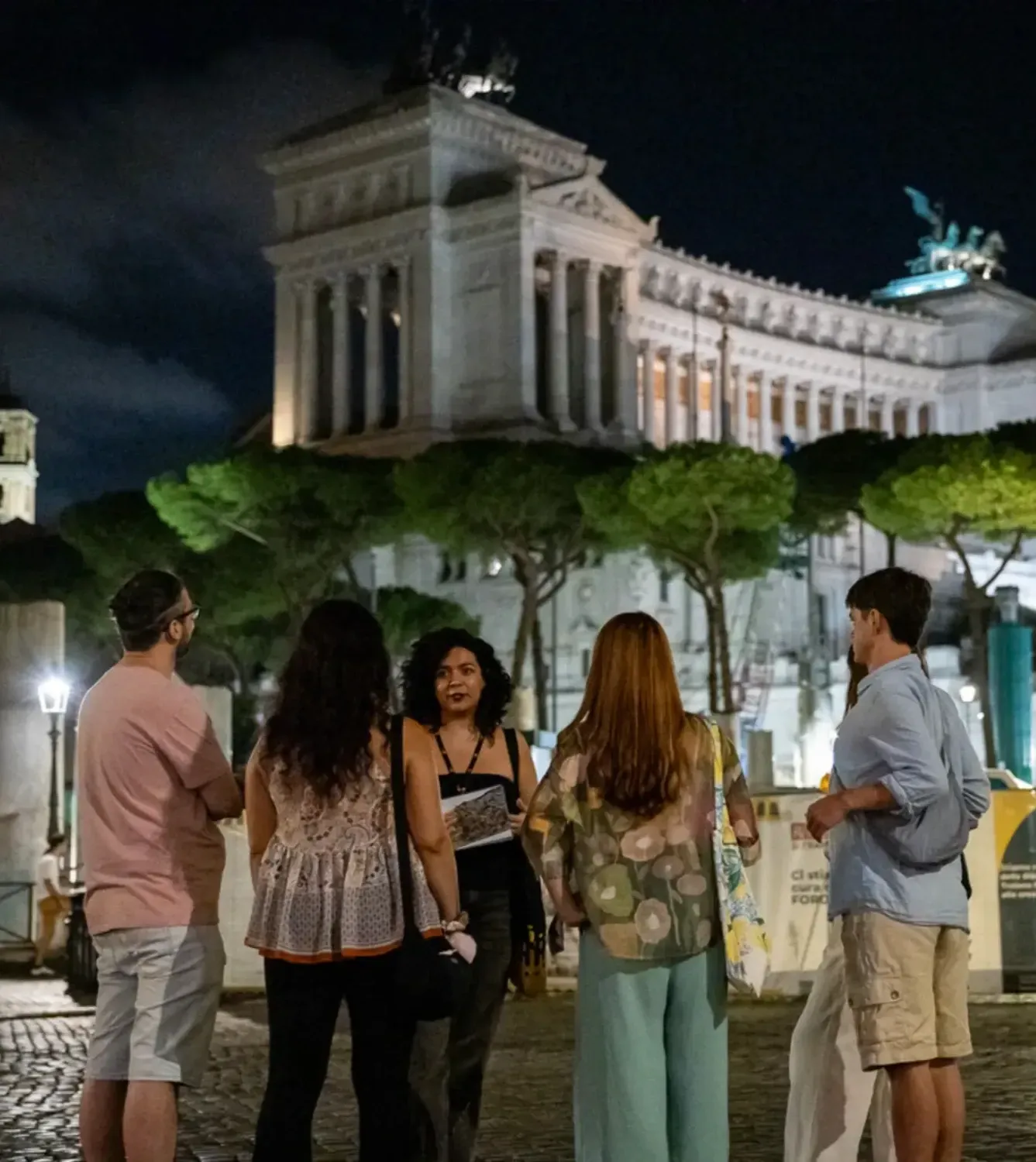
Join us on a journey through Roman history on our immersive Rome by Night Walking Tour. Your expert guide will share the city’s secrets, history, and fascinating tales—from antiquity through to the modern day, and at a pace to suit you.
Our tour starts in Rome’s most picturesque square, Piazza Navona, where the ancient Romans used to watch athletic contests (agones). Today’s piazza sits above the ancient stadium and boasts Gian Lorenzo Bernini‘s stunning Fountain of the Four Rivers as its centrepiece.
A five-minute walk from Piazza Navona takes us to the world-famous Pantheon. Constructed more than two-thousand years ago by the eccentric emperor Hadrian, the Pantheon was consecrated as a monument to all the pagan gods (pan theos, in Greek meaning all the gods). This second-century temple is one of the best-preserved monuments in the Roman Empire and its unreinforced concrete dome still perplexes architects.
Our next stop is the iconic Trevi Fountain. Immortalised by Anita Ekberg wading through its water in Federico Fellini’s iconic film La Dolce Vita, the Trevi Fountain one of the most romantic spots in the Eternal City. Snap your photos of the monument in the moonlight, listen to your guide decipher its symbols, and toss a coin over your shoulder to guarantee your return to Rome.
We emerge from Rome’s winding backstreets onto Piazza Venezia. Stretching from the foot of the Capitoline Hill, against the backdrop of the Altar of the Fatherland, Piazza Venezia is Rome’s most recognisable square, and a repository of history involving figures from Napoleon to Mussolini.
Your guide will lead you down the Via dei Fori Imperiali, the boulevard that cuts through ancient Rome, past Trajan’s Column and alongside the forums of Trajan, Augustus and Nerva. Your guide will feed your curiosity and nourish you with knowledge about ancient Rome and its empire as you make your way towards the most famous monument of all: the Colosseum.
The Colosseum is one of the most awe-inspiring attractions that has survived from antiquity. As a colossal feat of architecture and engineering, its form has been replicated throughout the ages, manifested in stadiums and sports venues around the world. But while its form is familiar to us, the spectacles it accommodated are entirely alien, and remind us of the violent nature of Roman culture.
Group sizes are 15 people maximum.
Book your spot now to avoid missing out!
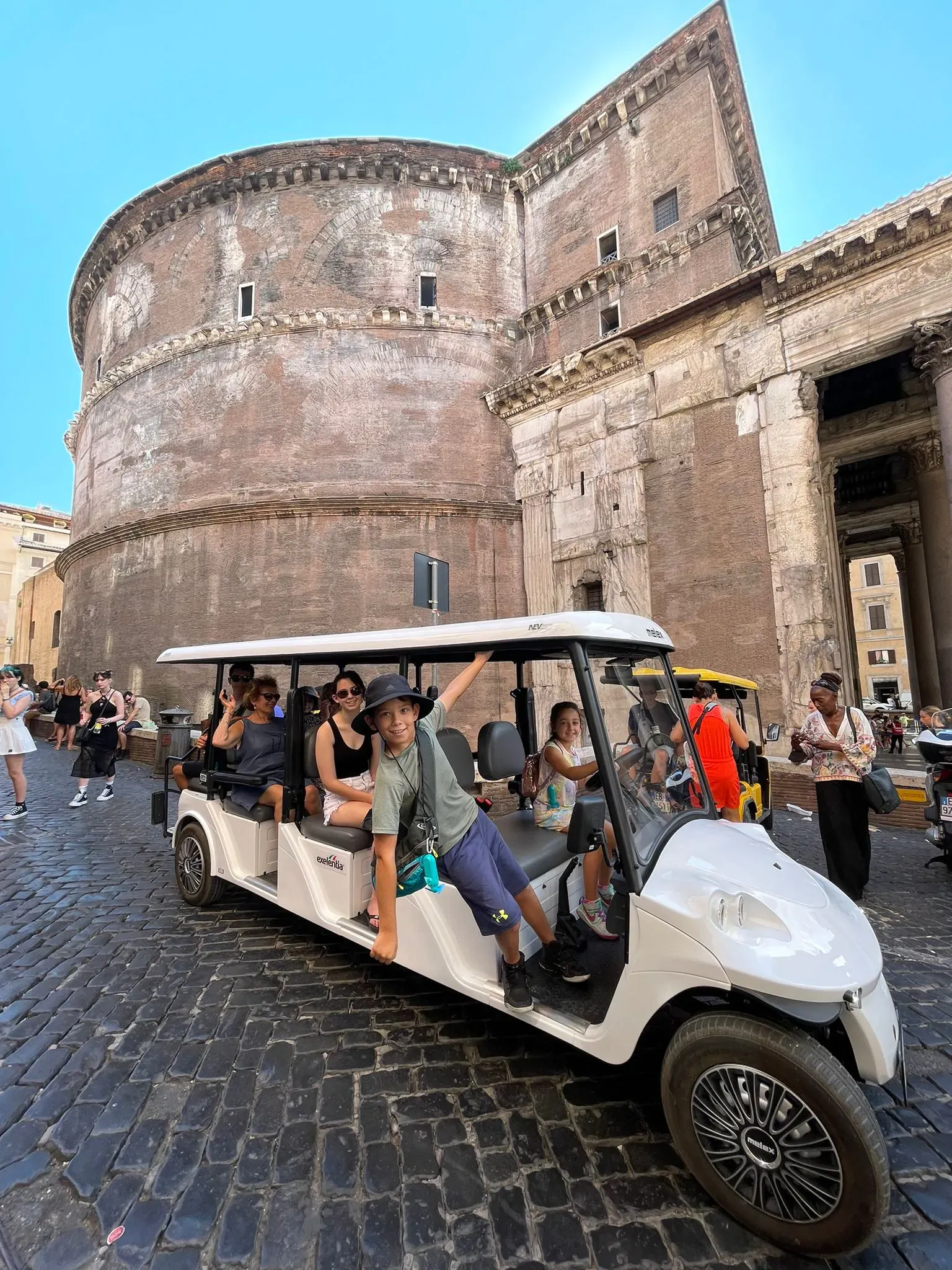
Although our Rome Golf Cart tour follows a tried-and-tested itinerary, upon special request it can be 100% customisable—so you can hone in on the attractions that interest you most.
Forget the fatigue of traipsing around the Eternal City. This tour saves you time and energy as you see all the capital’s must-see sites in half the time. Jump aboard your horseless chariot and let us chauffeur you around Rome in comfort and convenience. Enjoy exclusive access to traffic-limited areas, and enjoy hopping on and off your golf cart straight at the foot of your attraction of choice.
Visit the stunning Trevi Fountain, immortalized in Fellini’s classic film La Dolce Vita, and throw a coin over your shoulder to ensure your return to Rome! Admire the tumbling terraces and balustrades of the famous Spanish Steps, and discover what exactly it is that makes the monument Spanish!
Gaze up in awe at the Pantheon, Rome’s best-preserved ancient temple, and learn the fascinating history of how it was founded and how it has fared. Drive to the foot of Piazza Navona, Italy’s most stunning square, which was built above an ancient structure your guide will bring to life.
Your Rome Golf Cart tour takes you up the Aventine Hill, where Romulus’ brother Remus tried—but failed—to found his city. Pass by the Orange Garden, stopping off to enjoy its views, and check out the famous Keyhole View over Saint Peter’s Basilica and the Territory of the Order of the Knights of Malta.
Stop off at the famous Mouth of Truth situated right by the River Tiber in the area where Rome was founded. This stunning stretch of road around the most ancient part of the Eternal City also takes us past the Theatre of Marcellus (a building started by Julius Caesar and finished by the emperor Augustus) and the impressive Capitoline Hill.
You can choose where your tour finishes: in Rome’s centre, at your hotel, or wherever you want to explore next! If you’d like to visit the Colosseum, Castel Sant’Angelo or the Vatican on your Golf Cart Tour of Rome, we can also arrange for this, depending the time and location of your departure or finish point.
For all special requests, please contact us directly.
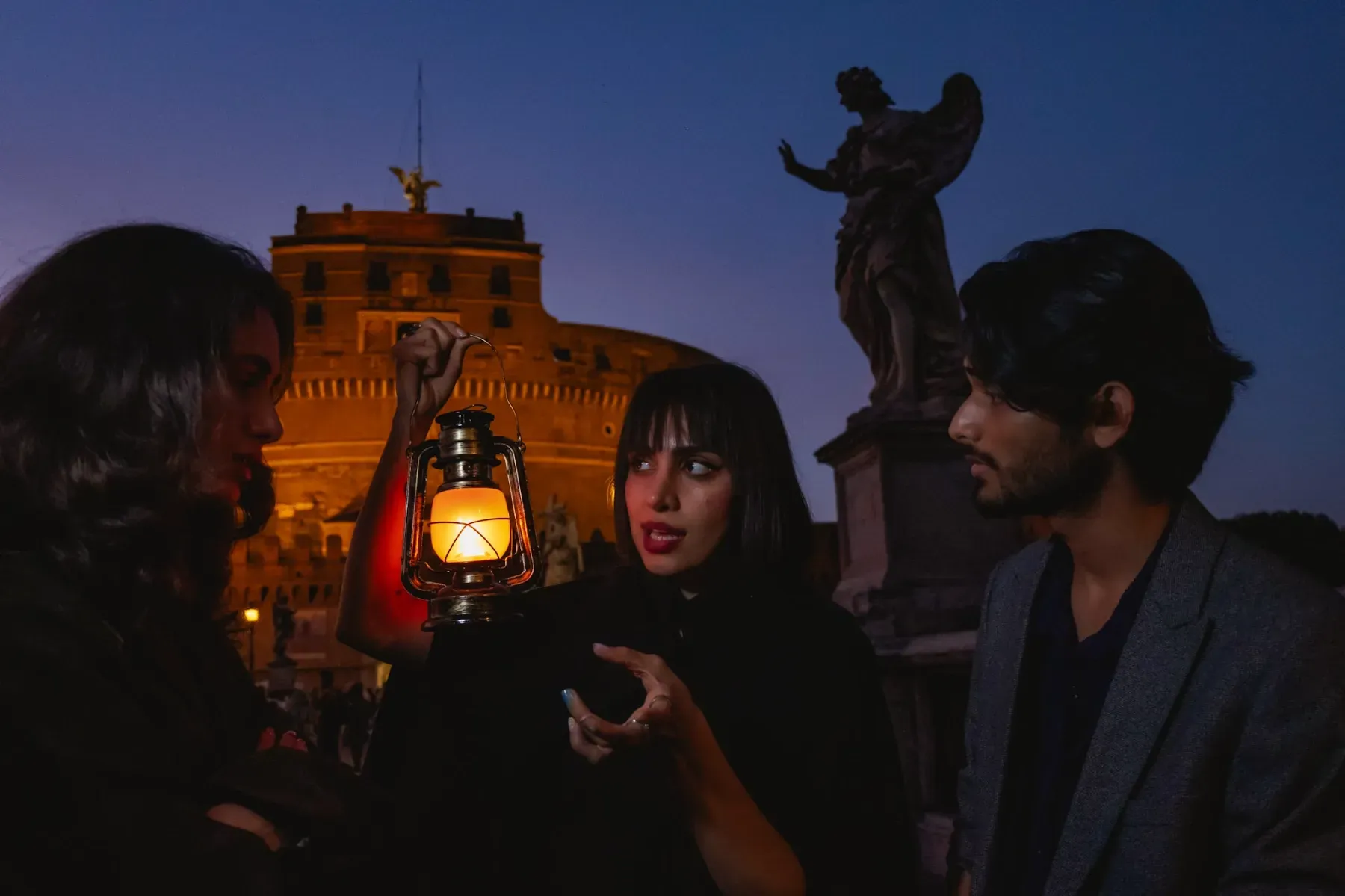
Rome may well be the world’s most beautiful city, but after dark a more sinister side emerges. The ghosts of popes, emperors, and artists lurk on every corner, their lives claimed by tragedy and conspiracy across more than 2,000 years of history. Our Rome Ghost Tour is not for the faint hearted — you’ll hear the ghastly tales of beheadings and murder that are sure to keep you up late at night.
Your Rome Ghost Tour starts at Campo de’ Fiori, a central square, where you’ll be treated to the tale of Giordano Bruno, one of Rome’s greatest minds who got on the wrong side of the church. After learning about his grisly end, you’ll begin to explore the city. Venture through medieval backstreets; visit an ancient church adorned with skulls; and step inside the home to a mysterious order of monks. Discover the childhood home of one of Rome’s most infamous executioners; see the site of one of Rome’s most infamous prisons; and pass by a poisonous perfumery where cosmetics killed.
Your tour ends at the imposing Castel Sant’Angelo, where your guide will reveal the horror of Rome’s most disturbing executions. If you’re (un)lucky, you might even encounter a ghost or two.
No matter what, you’ll never see Rome the same way again.

Twirl, sip, and soak up the seasonal cheer, because from December 1st to January 6th, we’re giving our usual class a holly-jolly glow-up. You’ll stir up a limited-edition cocktail packed with Yuletide spirit and finish with a classic Italian Christmas treat.
Did someone say Spritz? Discover the flavours of Rome on our Spritz and Spaghetti Class. Our centrally located kitchen is where you’ll learn everything you need to mix traditional Italian cocktails, and perfect the art of making fresh pasta. This is the only cooking class of its kind in Rome – a perfect blend of food, friends, and tipsy fun. So come join us and see what all the fuss is about!
Our team will welcome you and your small, intimate group with a mixology demo making Italy’s best-loved drink: Aperol Spritz. You’ll then get started on your hands-on pasta-making lesson led by a fun-loving, fluent professional chef before making a Hugo Spritz.
Your professional chef will guide you every step of the way – from kneading the dough to cutting the pasta. You’ll also be making a creamy carbonara sauce to coat your fresh pasta (vegetarians can try out another Roman classic of cacio e pepe). Travelling is all about meeting new people. At the end of this cooking class, you’ll dine on what you’ve made with a glass of Limoncello Spritz to wash it all down.
Book now and start making memories.

One of the best ways to meet people in a new city is to grab a drink together, and few city serve up more iconic drinks than Rome. Whether you’re travelling solo or with a group, for a long vacation or a short city break – our Rome Tipsy Tour is for you!
This unique nightlife experience combines all our favourite elements of travel: discovering new places, being immersed in different cultures, meeting fun people, and trying out a range of delicious drinks! It’s not a run-of-the-mill bar crawl. It’s a sociable tour that gives you a real taste of with Rome’s sights, stories, and signature drinks in a friendly, relaxed atmosphere with fun, local hosts. We also welcome sober travellers who want to join for a social experience but who want to forgo a hangover, so we’ll have non-alcoholic options available as well!
You’ll meet your guide and group at Piazza Madonna dei Monti, where we’ll break the ice with a warm Italian welcome – aka, a refreshing glass of local wine. After saying cheers—salute—we’ll head into Monti, an uber-trendy district filled with quirky bars and cobblestoned streets, and plenty to unpack. In ancient Rome, Monti was known as a suburra – the red-light district of Rome where prostitutes plied their trade and gangsters once roamed. As we wander through the cobblestone streets your guide will tell you scandalous stories of sex and bloodshed that you won’t hear on your typical walking tour.
After so much scandal, you’ll surely need a drink. So at our first stop on the Rome Tipsy Tour you’ll get an extra stiff one. The spotlight will be on Carpano Classico a venerable vermouth with a curious story! Unravel the history of the man who made it – Antonio Benedetto Carpano – back in 1786 whilst sharing some sips with your newfound friends.
We’ll keep the night going with some more saucy stories before trying a classic Italian Spritz. Indulge in the bitter flavours of Aperol or Campari Spritz while enjoying dolce far niente, the sweetness of doing nothing—apart from getting tipsy of course!
Our final stop is Rome’s most iconic road, the Via dei Fori Imperiali, leading down to the Colosseum. The views of the ancient city are best enjoyed after dark with an ice-cold Limoncello – trust us. Sip away as your guide tells shocking stories of the power-hungry Roman emperors who once ruled the known world.
At 11 p.m., the Tipsy Tour officially ends, but the night out begins! We will continue drinking with our new friends at some of Rome’s most popular bars!
Don’t miss out on this once-in-a-lifetime experience. We promise to make your night in Rome one you’ll never forget! Skip a boring walking tour, and come get tipsy with us.
Book your spot now!
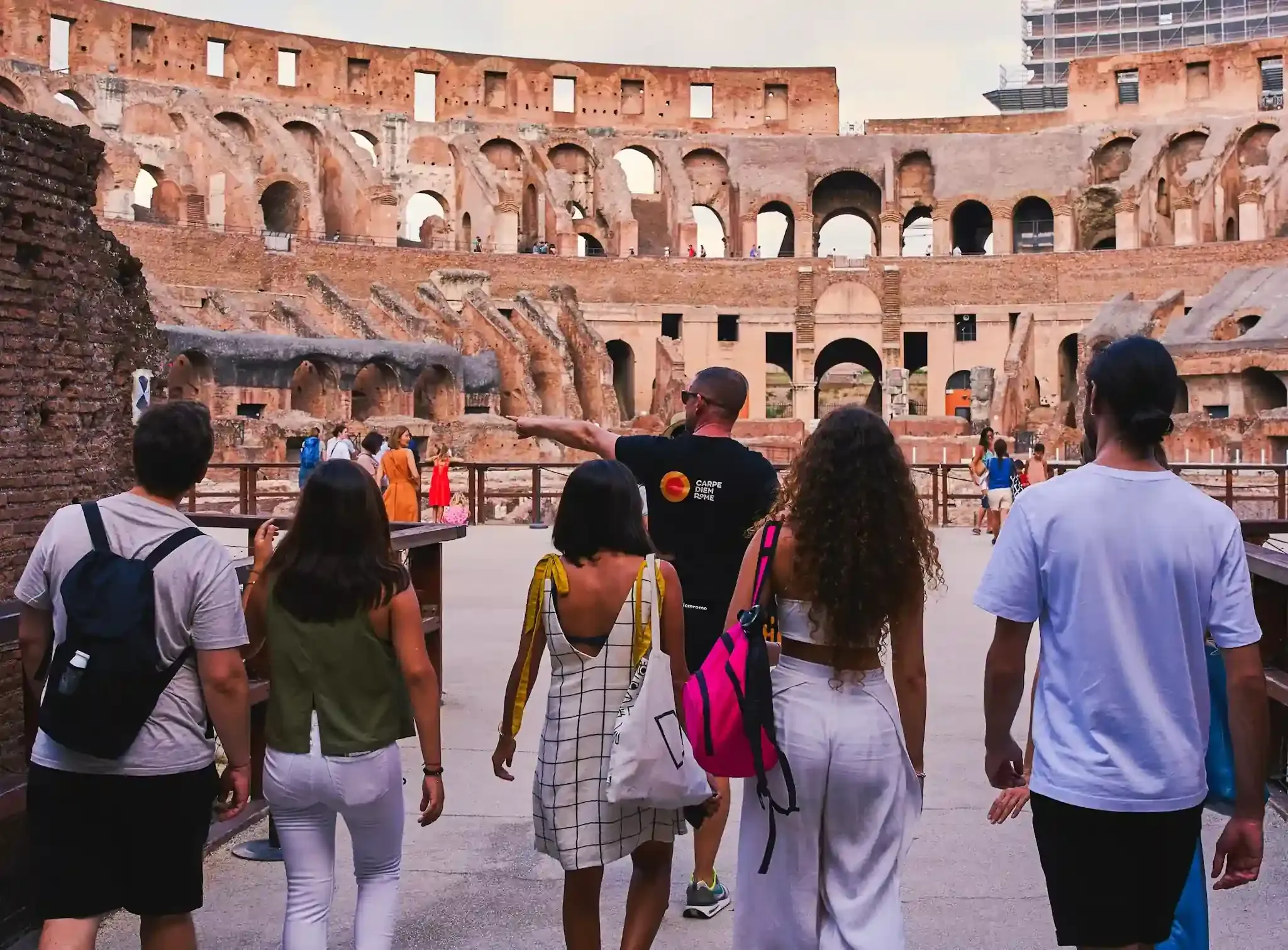
Ready to travel back in time to experience the might of the Roman Empire? Our small-group Colosseum guided tour lets you step straight into ancient Rome, no time machines (or long lines) required. With timed -entry and fast-track access and an expert licensed guide, you’ll breeze past the queues and straight into the jaw-dropping world of emperors, gladiators, and ancient stories that will stick with you forever.
We’ll start our 3-hour adventure at the Colosseum, Rome’s most famous amphitheatre and the site of some of the most bloody public spectacles in history. Your guide will reveal the story and secrets behind this impressive monument and provide answers to your burning questions:
The answers might surprise you, but not more than the exclusive above-the-arena views that offer a new perspective of the Eternal City.
After your immersive Colosseum tour, we’ll ascend Palatine Hill, Rome's legendary birthplace. It was here that Romulus founded his city, after murdering his brother Remus, and here where the rich and famous of the Roman Republic had their homes. During the time of the Roman Empire, the Palatine Hill was the site of the emperor's palace, royal intrigue, and some of the city's best panoramic views. This is where myths met marble, and emperors ruled with an iron fist.
Then we will head down into the Roman Forum, once the buzzing hub of Roman public life. We’ll wander through the ruins of ancient temples, triumphal arches, and the political stages that shaped the Roman Empire, all brought to life through the expert storytelling of your licensed guide.
With the comfort of a small group, a well-paced itinerary, and the best value for money of any Colosseum tour, this isn’t just a tour, it’s a once-in-a-lifetime experience through the rise (and fall) of ancient Rome. Spots fill fast, so grab yours and make your Roman holiday legendary.
Travelling with 6 or fewer people? We recommend upgrading to our semi-private tour of Ancient Rome for a more personalised experience. With this semi-private Colosseum tour, you can explore at a more relaxed pace, enjoy a more intimate experience with the people you care about most, and experience the personalised attention of a guide who can answer all of your burning questions.
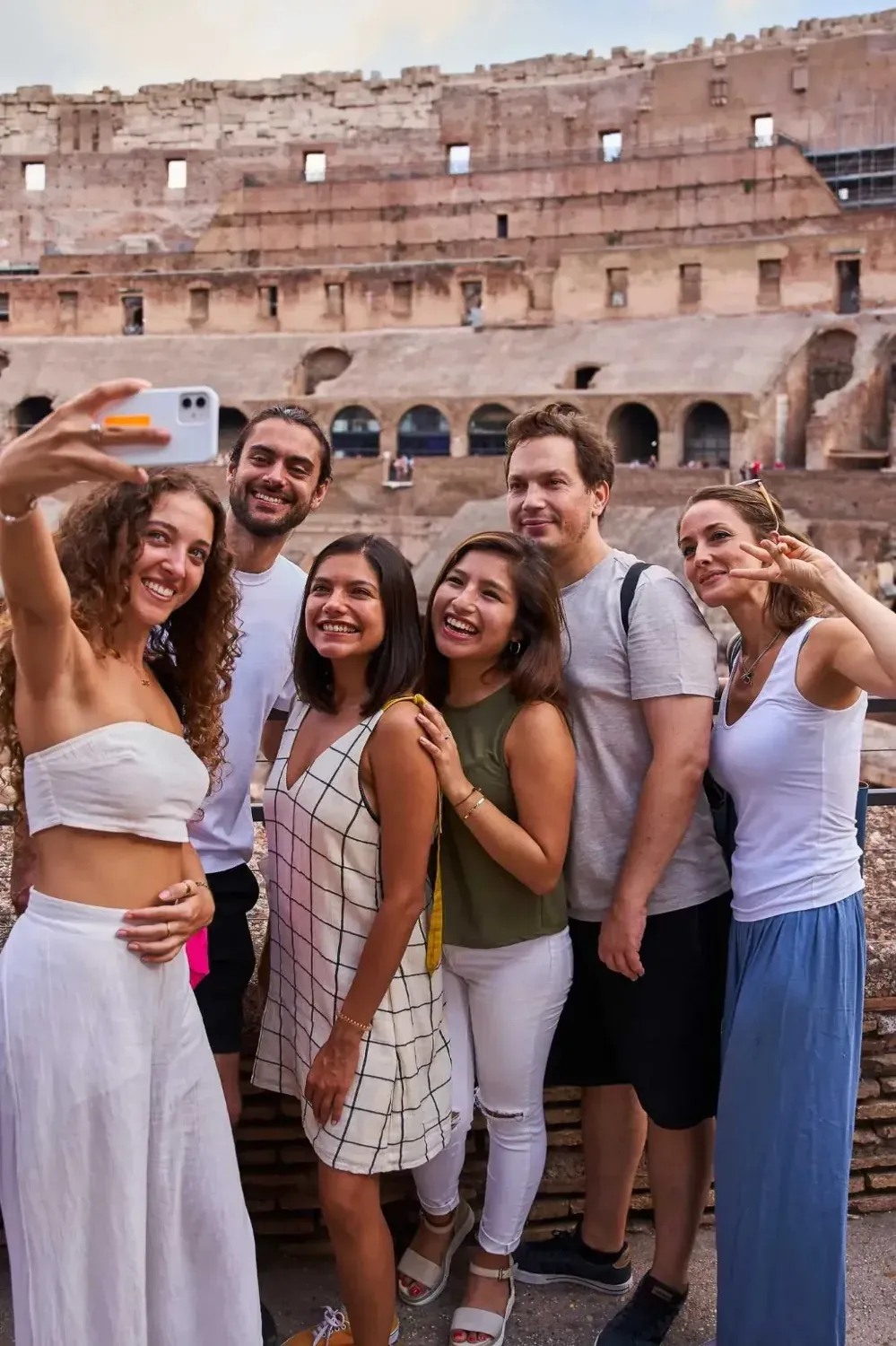
Go back in time on a once-in-a-lifetime, semi-private exploration of Ancient Rome’s most legendary landmarks—the Colosseum, Palatine Hill, and Roman Forum.
Designed for comfort and connection, this semi-private tour is limited to just 6 guests, giving you more one-on-one time with your expert guide, a relaxed pace, and the opportunity to dive deeper into the stories that fascinate you most.
With priority, fast-track access, you’ll also glide past the crowds and straight into the heart of the Eternal City. Save time, avoid the stress, and make the most of every moment with the people who matter most to you.
Your 3-hour journey begins inside the iconic Colosseum. We’ll take in the breathtaking views from above the arena that most visitors miss. Here, you’ll stand where gladiators once battled and hear captivating tales of emperors, epic contests, and ancient innovation. With fewer people in your group, your guide can personalise the experience, answering your most burning questions and focusing on what interests your group.
Next, we’ll ascend the legendary Palatine Hill, the mythical birthplace of Rome and site of the Empire’s most extravagant palaces. Then, descend into the Roman Forum, once the bustling centre of Roman public life. As you walk through the ruins of temples, arches, and political buildings, your guide will bring the ancient world to life.
This isn’t just a tour, it’s a meaningful journey into history, crafted for curious travellers seeking a deeper, more intimate Roman experience.
Prepare for a unique, unforgettable journey through Rome’s most famous landmarks with a small, friendly group that lets you explore at your own pace.
